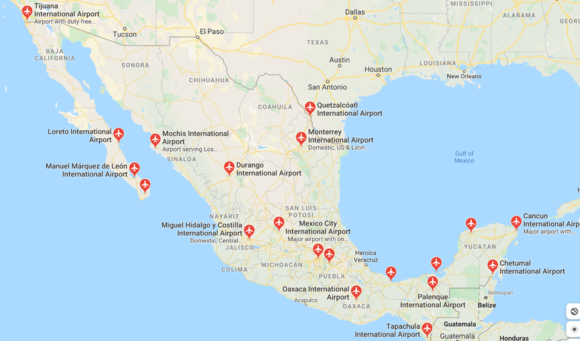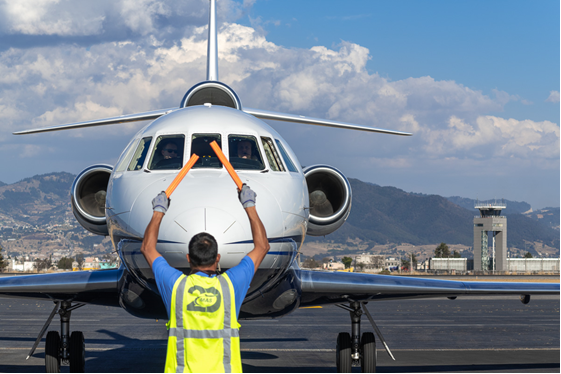
We have told you in the past about the escalation of ramp inspections in Mexico over the past year. There have been several interesting developments over the past few months that have made this topic go from a nuisance to a full-blown operational concern going forward.
The following has been published by Manny Aviation, an established ground handler in Mexico.
“Civil Aviation Authority in Mexico (fka DGAC) has changed its name to AFAC (Civil Aviation Federal Agency) as of October 16th. As part of its change, part of broader overhaul authorities are undergoing, some departments within the agency have changed the way they operate and some procedures are being modified.
Unfortunately, it is yet too soon to brief you accurately on specific changes. Moreover, some changes might be overturned in the end due to its lack of practical application. What we can share with you so far is the following:
- INSURANCE – The department in charge of Insurances and Bonds has a new person in charge. The criteria for the validation and acceptance of Mexican insurance policies as well as Worldwide insurance policies, are now more strict.
Mexican Insurances for one are being required in Original as most policies have been rejected if signatures are blurry, a payment receipt is missing, or a hard color print is noticeable, for instance.
Worldwide Insurance policies are now required to be submitted in full, where coverage, proof of payment as well as aircraft details are clearly shown. Certificates of Insurance, on the other hand, are being rejected mostly when they make clear reference to a policy number, thus making AFAC ask for the Insurance Policy in reference rather than the certificate.
- Power of Attorney – In the past, and given the relentless nature of unscheduled aviation, a simple copy of a signed power of attorney was sufficient to prove legal representation of an operator and gain the ability to submit applications, start and follow up on processes like landing authorizations, etc. on each company’s behalf. Now, and promoted by the same attorney in charge of Insurances and Bonds, a POA also requires to be in original, but also notarized and apostilled. As of now, this has been a request which has not been made official. Furthermore, for single landing and next day/short notice operations, a digital copy (still, notarized!) is being submitted and a commitment is made to provide the Original with its corresponding apostille to their central office once available.
About the above, there’s something worth to mention: Both points are considered, based and protected by the law. They were not duly enforced or there were times with a more lax criteria that clearly was implemented to keep the planes coming and avoid further delays. Yes, it is still the same playbook, just different interpretations of the rules.
Finally:
- Aircraft documents – Not much has changed in this regard, with the exception of the Insurances as mentioned above. The following docs must ALSO be on board for all flights:
- Aircraft Registration and Airworthiness *Original needed*
- WW Insurance*Original needed*
- AOC
- Radio License
- Medical certs for PIC and SIC*Original needed*
- PL for PIC and SIC
- Mexico Insurance(Commercial) *Original needed*
- Department of Transport Ops Specs 4507 form
- (PLEASE always make sure it’s the most up to date)
- SINGLE LANDING AUTHORIZATIONS (ONE TIME SHOTS) – Saved the best for last. AFAC seems to be aiming to reduce or eliminate the ability for one time authorizations. In the past and for a long time, an operator could obtain as many as 5 authorizations before CAA deemed necessary or mandatory, to start the process for an Indefinite Blanket Permit should the operator need to continue flying into Mexico. The number was then reduced to 3, back to 5, and all of this with no change, update or executive order whatsoever. It just became a common practice. Now, we have been notified, reminded rather, about the need to start and obtain an Indefinite Blanket Permit should the operator need to continue flying into Mexico after that Single Shot. A “single shot” will soon be just that. It is imperative to be proactive and start due process in all instances it becomes necessary. As a reminder, once the process has been started, landing authorizations could be obtained on a case by case basis while the permit is undergoing and until it is issued.”

Subsequent to this notification, the following additions and clarifications came out of Mexico from Manny Aviation.
“We hereby inform you that the Federal Civil Aviation Agency (AFAC) is conducting random ramp inspections on foreign aircraft visiting Mexico. As a reminder, AFAC has the authority, right and faculty to enforce such inspections at their disclosure. It is very important that operators, Private or Charter, have their original aircraft and pilot documents on board. These include but are not limited to:
1) Airworthiness Certificate
2) Registration Certificate
3) Worldwide and/or Mexican Insurance stating Private use when flying Far Part 91 and Charter use when flying Far Part 135. When flying Far Part 135, it is mandatory to have both insurances: worldwide and Mexican.
4) Pilot's licenses: both sides and stating aircraft type rating.
5) Pilot´s medical certificates: valid document according to crew role (Pilot in Command or Second in Command), type of flight and according to pilot´s age.
6) If holding Multiple Entry Authorization (MEA), this document and its corresponding payment receipt, must be on board.
7) For Charter operations, the following additional documents are required:
a. Valid Air Operator Certificate (AOC): Copies are accepted considering this document might include many tail numbers (fleet). Payment receipt should also be included.
b. FAA OST 4507 FORM copies are accepted considering this document might include many tail numbers. Alternatively, the appropriate exemption document, Certificate of Public Convenience and Necessity is also accepted.
c. If holding a Mexican Indefinite Blanket Permit (IBP), this should be accompanied by the Mexican AOC, and the Yearly Verification (including payment receipt) for it to be considered valid. Copies are accepted considering this document might have many tail numbers.
8) The logbook (maintenance logbook) stating the most recent information about maintenance performed on the aircraft.
9) The authorization to operate as a mobile radio aeronautic station; (Aircraft radio station license/authorization).
10) The Flight Manual.
11) Noise Certificate.
12) The Minimum Equipment List (MEL) when the type certificate indicates it.
13) Mexican AIP (only for Mexican IBP permitholders).
14) The preflight checklist.
15) If full or partial (inbound/outbound Mexico) route involves overflying the ocean, then a life raft and/or life jackets are required to be on board, according to the type of aircraft. Please note this is also a usual requirement, but Mexican CAA will also be double checking for this.
16) Weight and Balance Manifest.
17) First Aid Kit.
18) Jeppesen Manuals, (at least electronic format).
19) If operating Far Part 91 - Private flights, it is required to present a document stating the purpose of the flight, to include the name of the lead passenger and to declare its connection with the aircraft (owner, employees, etc). If accompanied, letter must declare the relationship of the passengers with the lead passenger (family, friends, employees, etc.). This will prove there is no commercial purpose under any circumstance. To present this letter, having it notarized is not necessary.
While there is no formal list of requirements to be presented at the time of inspection, those mentioned above are highly recommended. It is very important to be clear that AFAC has not provided a checklist per say, so it falls on the criteria of each inspector. They might ask for more or fewer documents than listed above.
These inspections are random on any foreign aircraft. Whether operating Private or Charter, operators will have to prove before AFAC if their flights are Private or Charter, as applicable, by their countries of origin. Regardless of whether landing authorizations are single or multiple, inspection will still apply. If operators do not comply with the requirements, a warning or a fine will apply per the Mexican Civil Aviation Law. Inspections have started up again on Nov 19th and will be permanent.”
You may be saying to yourself, “How does this affect me?” Because this is Mexico, this is a fair question. This is a significant undertaking and initially, the Mexican authorities will not have the manpower to do these inspections on every flight. Scott IPC suggests that you stay in touch with either your international service provider or your contacts within Mexico on just how this is playing out on the ramp. We believe that is it clear that business aviation can expect a high number of ramp inspections going forward.
For any questions contact Phil Tyler at This email address is being protected from spambots. You need JavaScript enabled to view it.
